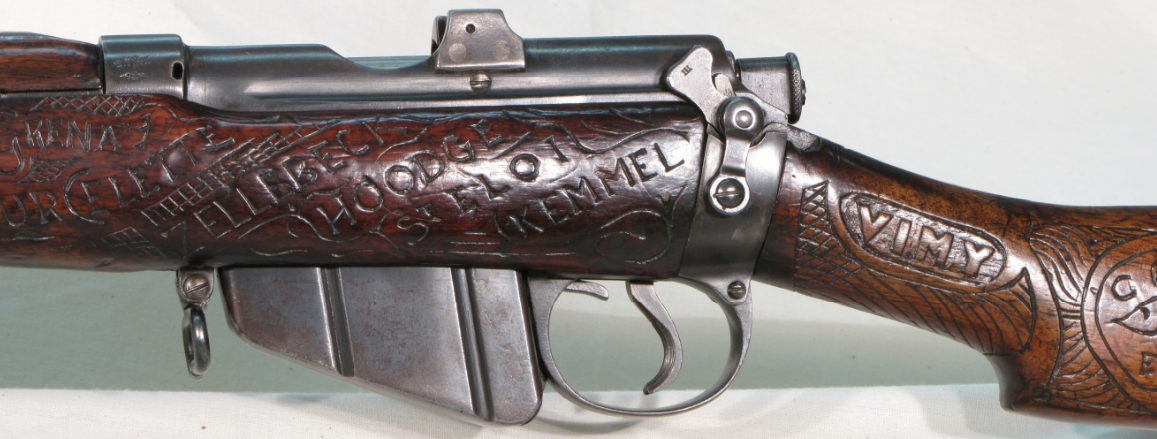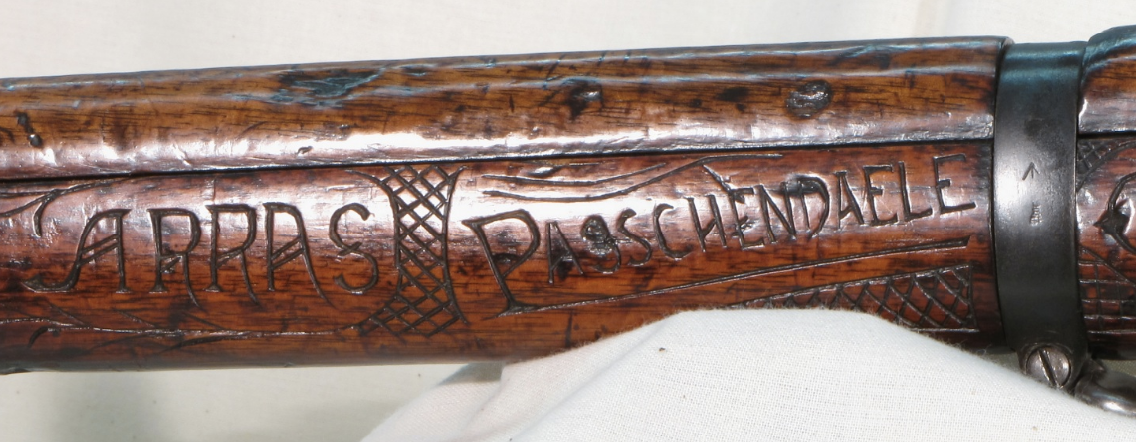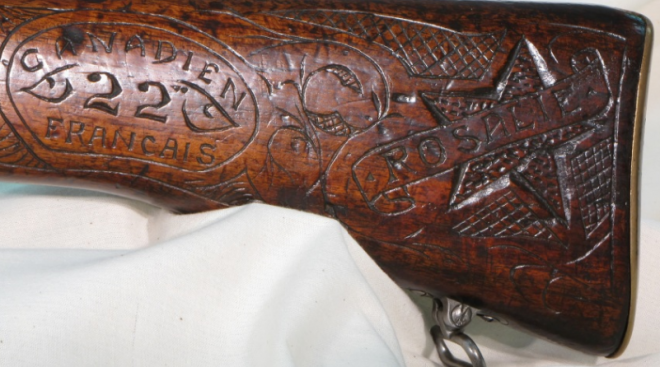Trench Art has always fascinated historians and collectors alive because it makes us have a personal connection with the curators of the various equipment it is displayed upon. But from an administrative standpoint, cutting up issued gear is no interesting manner, it is often punished through punitive actions. Such is the story of a Lee Enfield No.1 Mk III that was issued to a Canadian soldier during World War One. It is both the topic of an article in French and even a Reddit chain. Apart from the elaborate designs, the names on the rifle recount the various towns and battles that the soldier fought in.

I’m guessing that the soldier was right handed and that there were few carvings on the right side of the rifle. The side with all the carvings on it would have been the side that the soldier would have seen most of the time when he was serving with it assuming he was gripping it at port arms or pointing it out of a trench parapit.
A high definition picture in which you can zoom in can be found here. The gist of the story is that the rifle was issued to a Canadian soldier on the Western Front. The soldier started carving it up and he was punished for carving up the rifle, not once, but on two separate occasions and in two different units! The soldier was severely wounded and lost his weapon. Meanwhile someone took the rifle off the battlefield and it somehow found its way to RSA Enfield in England, where it was presented to a Canadian General during the Second World War and sent back to Canada. The soldier who had done the carving happened to see it in a museum on display in 1956 to which he was overjoyed at the reunion. This happened just years before he passed away in 1963. Altogether almost 30 years after he was wounded and lost sight of his weapon.
Here is a full account as translated by a forum member of the Canadian Expeditionary Force Study Group–
Henri Lecorre a French immigrant joined the 22nd Bn on April 14th 1915 with the service number 61835. When he received his service weapon he christened it Rosalie. Rosalie was a popular song that was sung by the folks back in France.The song pertained to women (Marraines de Guerre) who became pen pals to the soldiers at that time.
Lecorre started decorating his rifle by carving “Rosalie” along it’s stock. For having defaced the Kings property he was fined and jailed. The weapon was confiscated and sent to be destroyed. The rifle was recovered from a pile of scrap material that was destined for disposal. Lecorre ended up by regaining possession of his cherished weapon and carried it with him until it was stolen.
At that point Lecorre went to a French Tavern where he knew the rifle was kept. By posing as a military policeman he was able to “convince” the owner of the tavern to hand over the stolen property.
The rifle followed Lecorre from one battle to another. Each battlefield “Rosalie” visited was carved to the inside of the stock. Lecorre was very careful to ensure that “Rosalie” was not discovered by his superior officers. At one point the Commanding Officer discovered what was going on and was infuriated. Once again the rifle was ordered to be destroyed. And again, Lecorre with the help of a few friends was able to save his precious item. That night he carved the stock of another weapon and had the impostor thrown into the scrap heap.
Sometime later he was seriously wounded by rifle fire while trying to help two wounded buddies. We woke up in a hospital without “Rosalie”.
After the Great War, “Rosalie” was found on the battlefield and taken to the Royal Small Arms Factory in Enfield, England. In 1943 “Rosalie” was presented to General Andrew McNaughton. The inscription “22nd Infantry Battalion French Canadians” aroused his curiosity. He returned the weapon to the Royal 22nd Regiment where she belonged.
In 1956 Lecorre visited a military exhibit and recognized “Rosalie”. He was overcome with emotion and recounted the amazing story. Lecorre passed away on January 20th 1963.
His son Tex, a well known singer in Quebec wrote a song called “Frigidaire” in which the name “Rosalie” is mentioned.

If the names of these battles don’t give you goose bumps, maybe these figures will. Over 400,000 men were either killed or wounded during the 1917 battle of Passchendaele and over 200,000 during the Battle for Arras.
This is also roughly the same story that appeared in the March/April 2014 issue of The Canadian Firearms Journal. It is pretty amazing that there were multiple opportunities along the path this rifle took to become lost to history but it persevered, and you can still see it today if you’re in the Quebec area at the La Citadelle de Quebec museum. Myself and my enlisted brethren of the world can count this as a win against the ever watching authority of the dark side of the service, those officers.
All images are taken from the Gigapan photo file of the rifle.
 Your Privacy Choices
Your Privacy Choices

